ALLIES PLEDGE MUTUAL ASSISTANCE VS. AXIS
London, England • April 13, 1939
Following the Nazi occupation of Czechoslovakia’s German-speaking Sudetenland in October 1938 and the invasion and incorporation of the rest of Czechoslovakia into the Reich in mid-March 1939, Great Britain, France, Poland, Greece, and Romania entered into mutual assistance pacts in case of a military invasion by “a European power,” meaning Germany. In early April 1939 the partners consisted of just Britain, France, and Poland, although the three nations had not yet committed themselves to formalizing the arrangement.
On this date, April 13, 1939, Britain and France guaranteed the borders of Romania and Greece following Italy’s invasion of tiny Albania, Greece’s neighbor to the north, pledging to lend “all support possible” where there were clear threats to the independence of either country. On August 25, 1939, two days after the foreign ministers of the Soviet Union and Germany had signed the Molotov-Ribbentrop Nonaggression Pact, Britain and Poland initialed the Agreement of Mutual Assistance. The agreement contained promises of mutual military assistance between the nations in the event either was attacked by some “European country,” the name of which was spelled out in a secret protocol of the pact—Germany. The French government waited until September 4, 1939, one day after declaring war on Germany, to ratify a secret protocol to the 1921 Franco-Polish military alliance that had been signed the previous May.
After Germany’s conquest of Poland (1939); the Low Countries, Denmark, Norway, and France (1940); Greece and Yugoslavia (1941); and the enlargement of the Axis Tripartite Pact by Romania, Hungary, and Slovakia (November 1940), Britain stood practically alone against the Nazi bully. The single exception was Germany’s erstwhile treaty partner, the Soviet Union, since June 22, 1941, the object of Adolf Hitler’s colossal and suicidal military campaign in the east—Operation Barbarossa. When Germany and Italy foolishly joined Japan in declaring war against the United States in December 1941, the production, financial, and prospective military might of America was thrown into the balance against the Axis. British Prime Minister Winston Churchill expressed his relief at the turn of events, writing, “[T]o have the United States at our side was to me the greatest joy. . . . [T]o know the United States was in the war, up to the neck and in to the death. So we had won after all!” Churchill would eventually be proven right, of course, but the human cost was catastrophic and disproportionate—between 2.5 and 3 percent of the world’s population died in the global conflict, civilians accounting for two-thirds of the dead.
Scenes of German Military Incursions in European Cities, 1940–1941, and Aftermath
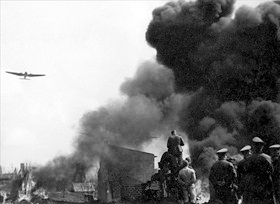 | 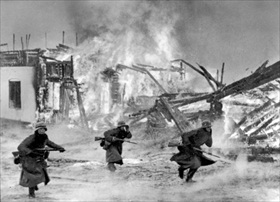 |
Left: German forces enter Poland’s capital, Warsaw, late September 1939. The German occupation of Poland was one of the most brutal episodes of World War II, resulting in the deaths of roughly 20 percent of the country’s 34.8 million inhabitants (1939 est.) and over 90 percent of its Jewish minority.
![]()
Right: German infantry attacking through a burning Norwegian village 25 miles west of Lillehammer, April 1940. In a country that had a population of barely 3,000,000, the Wehrmacht garrisoned some 300,000 troops in Norway for the next five years in collaboration with the puppet government of Vidkin Quisling. In the northern part of the country, where Soviet armed forces pressed their attack in 1944 and early 1945, the Germans employed a scorched earth policy, leaving over 70,000 people homeless and denying the inhabitants and the enemy food, boats, roads, and communication lines in the area. Out of an estimated 2,173 Jews in Norway in 1940, at least 765 died, 742 of them murdered in concentration camps.
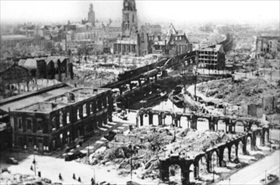 | 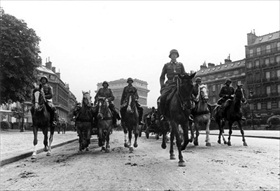 |
Left: Rotterdam’s central Blaak railway station destroyed on May 14, 1940, during the German terror bombing of Rotterdam (“Rotterdam Blitz”), which killed 800–900 Dutch civilians and destroyed 25,000 homes. By the end of the war, 205,901 Dutch men and women had died of war-related causes. Over half were Holocaust victims. Of the 140,000 Jews who had lived in the Netherlands before 1940, only 30,000 (21 percent) survived the war, a much lower percentage compared with neighboring Belgium and France.
![]()
Right: German troops enter Paris, France, June 1940. Protecting their homeland during the Battle of France, the French suffered 2.26 million casualties, of which 360,000 were killed or wounded. Prisoners of war and deportee totals were around 1,900,000. Of this, around 240,000 died in captivity. By the time of their liberation, some 580,000 French had died out of a population of 35.5 million (1940). Of the 350,000 Jews who lived in France in 1940, upwards of 90,000 died during the war, most (over 73,000) as deportees in German concentration camps.
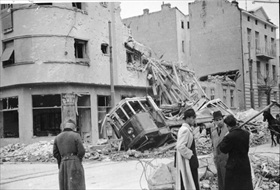 |  |
Left: Damaged street in Yugoslavia’s capital, Belgrade, 1941. On April 6, 1941, Hitler mercilessly ordered the Yugoslav capital Belgrade be bombed days after regent Prince Paul, who had initialed the Axis Tripartite Pact the month before, was deposed in a coup d’état and his young nephew Peter II proclaimed of age. When the air attack was over, some 4,000 Belgrade inhabitants lay dead under the rubble. During World War II a little over one million Yugoslavs out of a population of 13.9 million (1931 est.) became casualties (slightly more Partisans than collaborators), of whom 581,000 were civilian losses. Some 57,000 Jews, who made up less than one percent of the population, perished.
![]()
Right: German reinforcements enter Greece’s capital, Athens, May 1941. Greece’s civilian population of over seven million suffered horribly under Axis occupation. In Athens alone more than 300,000 civilians died from starvation, and tens of thousands more died in reprisals by Germans and their Greek collaborators. At least 81 percent (ca. 60,000) of Greece’s total prewar Jewish population died during the occupation.
Operation Marita: Nazi Germany’s Attack on Greece, April 1941
![]()

 History buffs, there is good news! The Daily Chronicles of World War II is now available as an ebook for $4.99 on Amazon.com. Containing a year’s worth of dated entries from this website, the ebook brings the story of this tumultuous era to life in a compelling, authoritative, and succinct manner. Featuring inventive navigation aids, the ebook enables readers to instantly move forward or backward by month and date to different dated entries. Simple and elegant! Click
History buffs, there is good news! The Daily Chronicles of World War II is now available as an ebook for $4.99 on Amazon.com. Containing a year’s worth of dated entries from this website, the ebook brings the story of this tumultuous era to life in a compelling, authoritative, and succinct manner. Featuring inventive navigation aids, the ebook enables readers to instantly move forward or backward by month and date to different dated entries. Simple and elegant! Click 











